Howdy, Stranger!
It looks like you're new here. If you want to get involved, click one of these buttons!
Quick Links
The Vermont Commemorative Half Dollar and the Bennington Medal - The Reverse that Might Have Been
On June 17, 1777 British General, John Burgoyne, set out on a mission that was planned to end or seriously cripple the American War for Independence. British forces, bolstered by hired Hessian soldiers, Indians, and Canadian and American Tories, would capture New York State and in doing so isolate the rebellious New England colonies from the rest of the American colonies. The British perceived that most of the hotheads were in New England, and that the rest of colonies would calm down once the British had subdued northern contingent.
Burgoyne's strategy featured a three pronged attack. Burgoyne's forces would advance south from Canada, down Lake Champlain and on to the upper Hudson River Valley. At the same time a smaller force would move east from Oswego, in western New York, and through the Mohawk Valley. Third General William Howe would move his New York City based forces north, up the Hudson River. The plan was for all three armies to merge at Albany, New York.
At first Burgoyne's plan went well. They easily captured Fort Ticonderoga which the Americans had already vacated and then routed an American force under General Arthur St. Clair after some fierce fighting. Burgoyne then proceeded south toward Albany anticipating that he would meet British General, Barry St. Leger who was leading the eastern prong of the British offensive. St. Leger was stymied at his siege of Fort Stanwix and was unable to come to Burgoyne's aid.
On August 3, Burgoyne got some more bad news. General Howe announced that he was going to attack the patriot capital, Philadelphia, and that he would not be supporting Burgoyne in his New York operations. This crushing blow came as a result of a imprudent order from London. Lord Germain, who was the British minister in charge of the conduct of the war, had ordered Howe to attack both in New York and Philadelphia. Unable to do both, Howe had opted to take the patriot capital, which he did with comparative ease.
Burgoyne was now in an untenable position. As he moved further south, a growing number of hostile patriots were sounding his forces, and he was running out of supplies. Burgoyne needed food and other material. He also needed horses to pull his wagons and cannon and to provide mounts for his currently dismounted German mercenary cavalry. Burgoyne sent German Lieutenant Colonel Frederick Baum with a force of mercenaries, Indians and Tories to take Bennington, Vermont where there were stores of goods that Burgoyne's army needed.
The Battle of Bennington is one of the most underappreciated victories of the American Revolutionary War. A militia force under General John Stark and the Vermont militia under Seth Warner routed the Hessians and their Indian and Tory allies in a pitched battle. Over all the British lost almost 1,000 men including over 200 dead and 700 prisoners who were marched to Boston. This defeat convinced Britain's Indian allies to leave the field and many of the Tory adventurers abandoned their posts as well.
The loss at Bennington helped to seal Burgoyne's fate. In two battles at Freeman's Farm and Bemis Heights, which are now known collectively as the Battle of Saratoga, the British were defeated and forced to surrender.
On November 4, 1777 the Continental Congress voted to award a gold medal to General Horatio Gates who was in charge of the American army at Saratoga. Unfortunately the Congress did not recognize others, most notably Benedict Arnold, who took a leading role not only in the battles of Freeman's Farm and Bemis Heights but also in the stalemate at Fort Stanwix which stymied the British advance from the west.
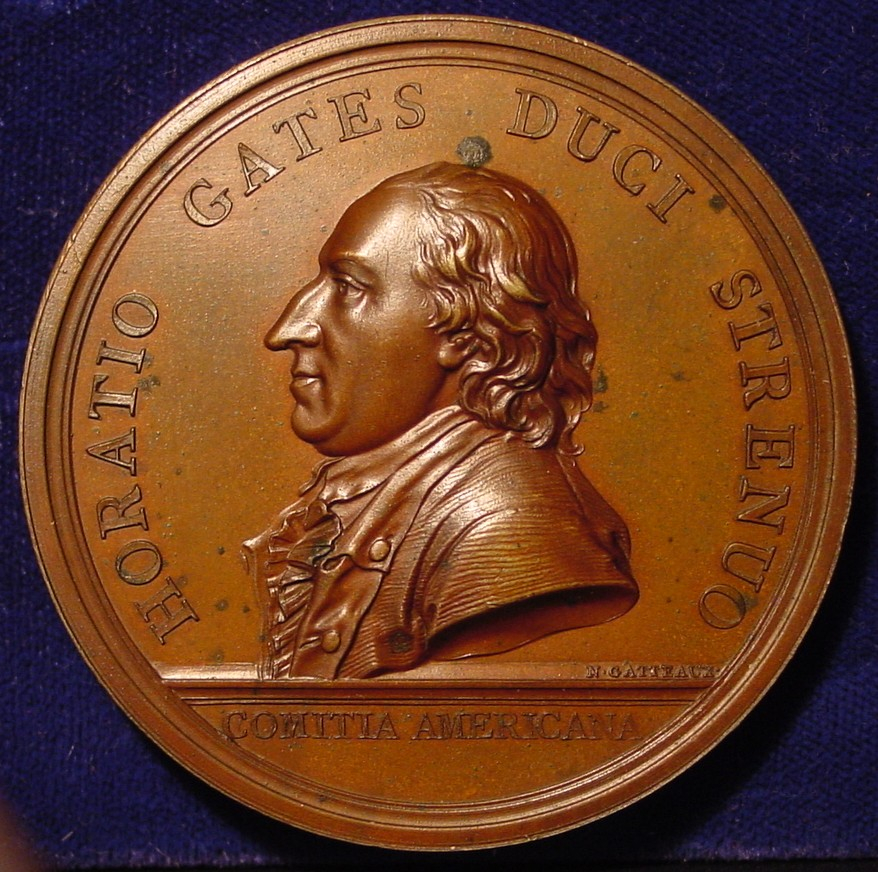
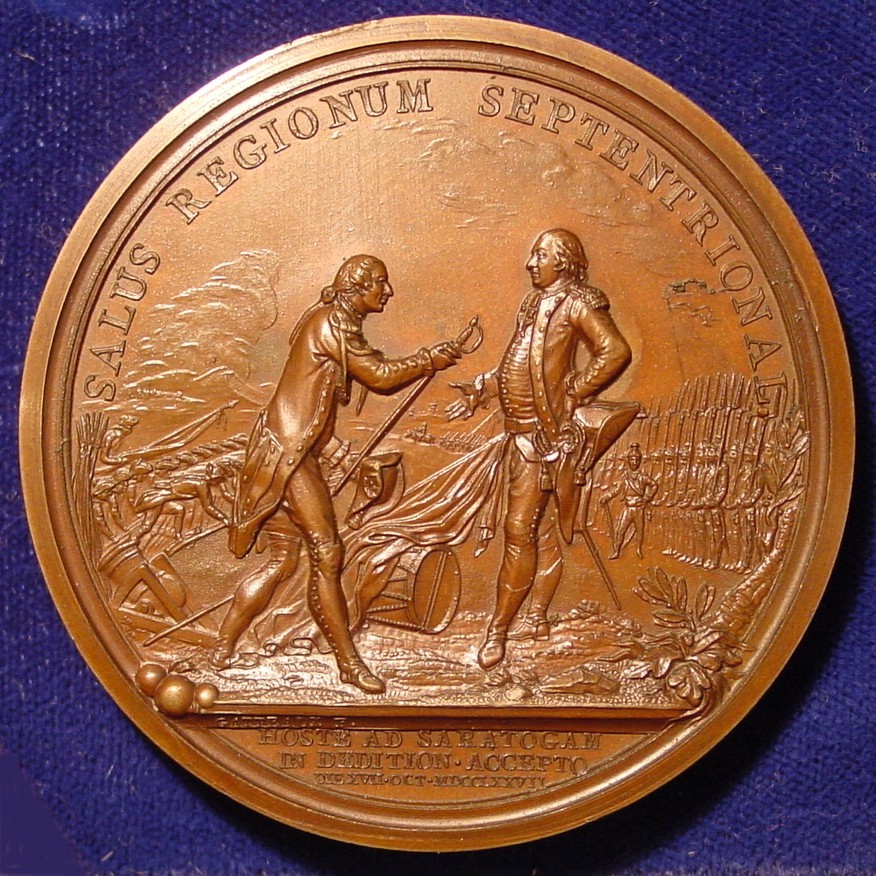
The Horatio Gates Medal in Bronze, struck from the original die pair.
Arnold was badly wounded in the leg at Bemis Heights, and it took months for him to recover. Had he died at Saratoga he would have been remembered as a great American hero. Instead his internal demons, plus his desire for fast riches and adulation took control of him, and he became one of the most infamous traitors in American history.
The historical significance of this American victory went much further than a major British defeat. Once news of the battle reached France, the French Government, with some persuasive urging from Benjamin Franklin, made monetary and military commitments to the American cause for independence. The French commitment was based more a desire to embarrass, weaken and humiliate their long time British enemies than to advance the American ideals of liberty and equality.
Fast forward 150 years. In 1925 Congress voted to authorize a commemorative half dollar that would celebrate the sesquicentennial of Battle of Bennington and the independence of Vermont. The coin was to be issued in 1927, and the Vermont Historical Trust would use the funds from the sale of the coins to promote the study of Vermont and American history.
Final approval for the design of the Vermont commemorative half dollar was in the hands of the Fine Arts Commission. In some cases the commission acted as a rubber stamp, but in this case their "advisory role" became extremely heavy handed. The Fine Arts Commission vetoed almost all of the design ideas proposed by the Vermont Sesquicentennial Commission which was led by John Spargo.
The Fine Arts Commission rejected the initial design proposal by New England artist, Sherry Fry. It featured a small, unflattering portrait of Ira Allen, whose more famous big brother, Ethan Allan, was known for his leadership of the Green Mountain Boys. Ira, however, was the more historically influential of the two. The reverse of the Fry design pictured the Bennington Battle Monument, an obelisk that is over 300 feet high. After the rejection of his work, Fry bowed out of the project.
The Vermont Commission then hired Charles Keck to design the half dollar. Keck's initial design included a better portrait of Ira Allen on the obverse and view of Fay's Tavern on the reverse. Fay's Tavern had been a place where Ethan Allen and his men had met to drink and plot their strategy. Keck also developed an alternative "war trophy" reverse which included a drum, banners, crossed swords and stacked muskets.
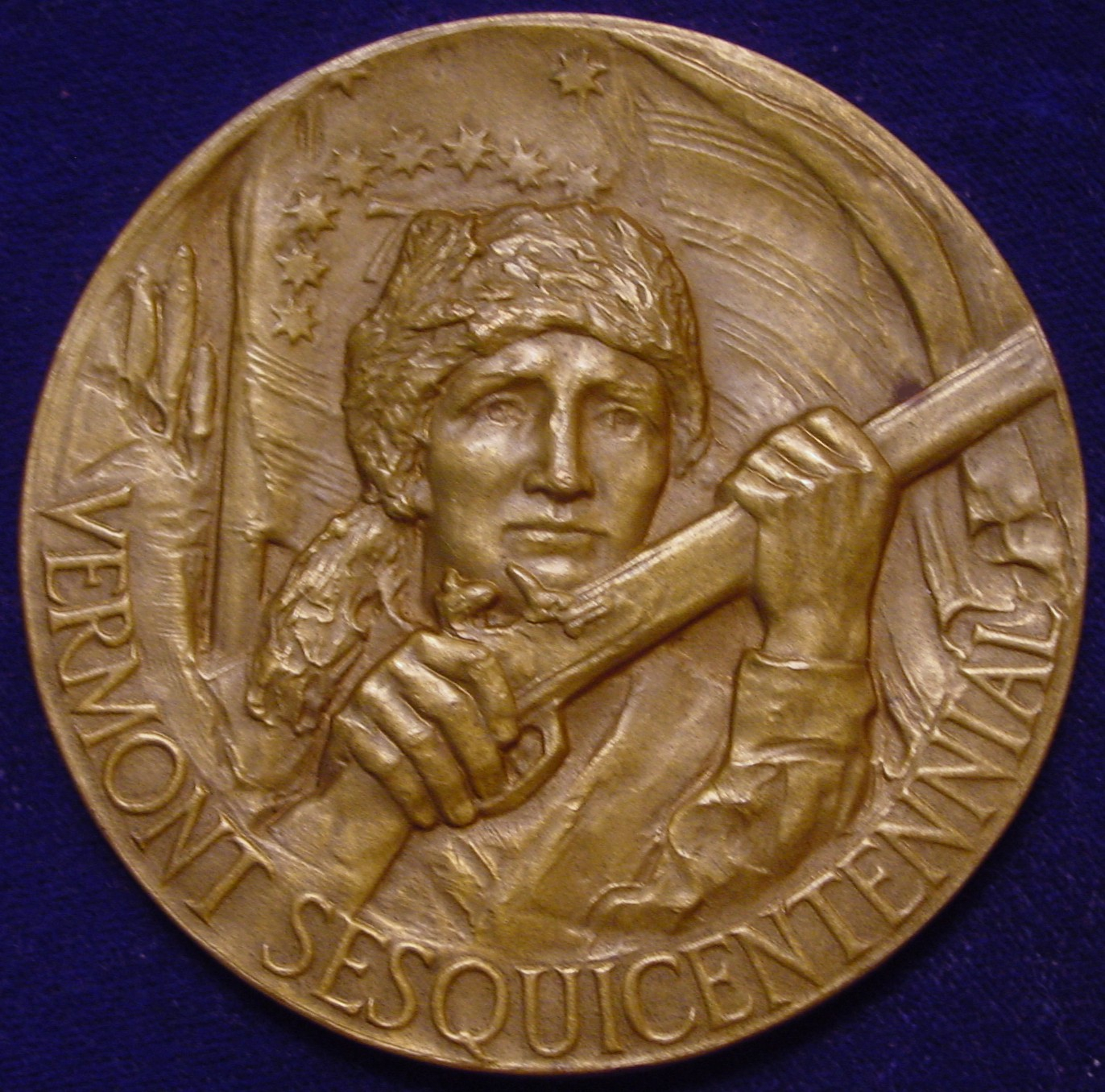
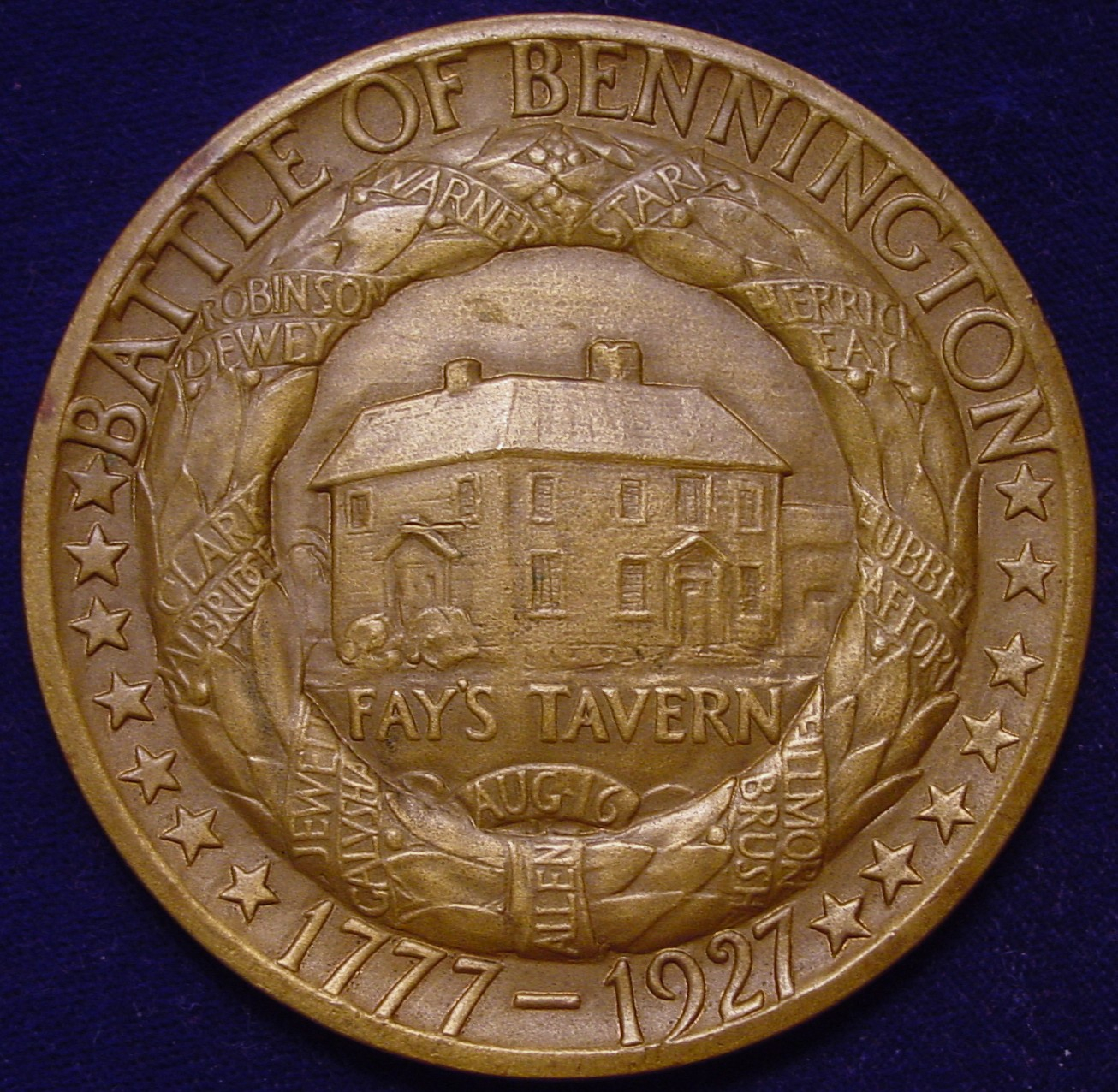
The reverse of the Bennington Battle Medal was the first design proposed for the Vermont commemorative half Dollar. The Fine Arts Commissionn rejected it.
The Fine Arts Commission rejected the appearance of the tavern because they ruled that it was "an inartistic subject for a coin." In its place they strongly suggested that a catamount (a mountain cat) would be more appropriate. One of the alternative names for the watering hole had been the "Catamount Tavern." At one point the patriots had killed one of the beasts, stuffed it and used it as a sign to the British that they were not welcome there.
The catamount ultimately appeared on the reverse of the Vermont commemorative half dollar. Although it might be fine art, which many coin collectors admire, the symbolism has since been beyond the comprehension of most observers.
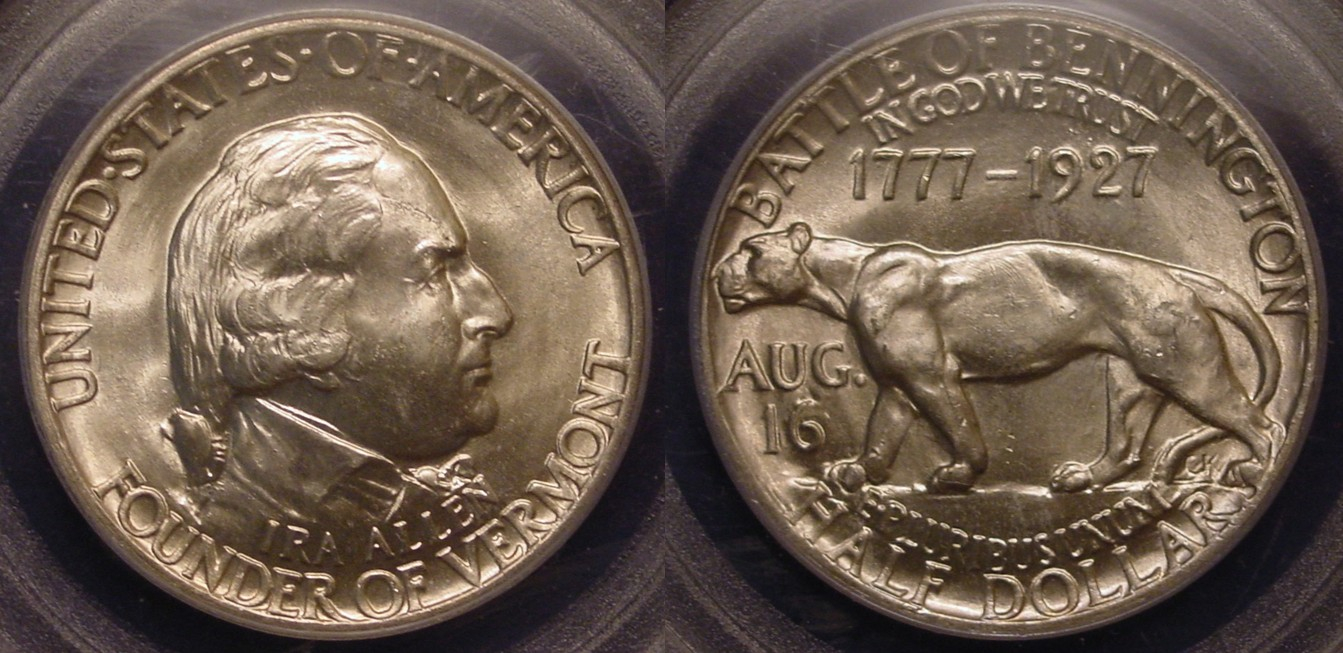
The Vermont commemorative half dollar.
In addition to the half dollar, the Vermont Sesquicentennial Commission also issued a commemorative medal. The Bennington Battle medal features a tribute to the backwoods militia men who fought the battle on the obverse, and the rejected view of Fay's Tavern on the reverse. The medal was also designed by Charles Keck, and in my opinion is a more appropriate tribute to the men who won the Battle of Bennington than the commemorative half dollar.
The Medallic Art Company reduced the models for the medal and half dollar from Charles Keck's plaster molds and stuck the Bennington Battle medal. Medallic Art charged the Vermont Commission $1 for each medal and the Commission sold them for $2 each. Overall the Commission ordered 500 medals, but Medallic Art produced additional pieces which they sold. The evidence of this were payments for royalties that Medallic Art made to the Vermont Commission. In addition there were six medals struck in "solid silver" that awarded to various dignitaries.
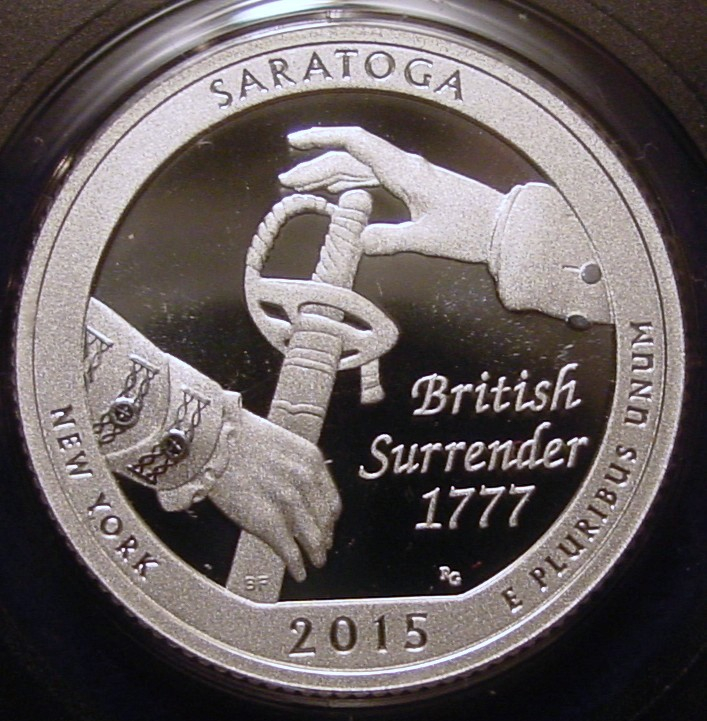
The reverse of the 2015 Saratoga America the Beautiful quarter.
In 2015, the U.S. Mint issued another tribute the Battle of Saratoga as a part of the America the Beautiful quarter program. The Saratoga, New York quarter features a sword held in an outstretched British military hand offered to an American hand in an act of surrender. The design on its surface appears to be overly simple. It is probably an acknowledgement that a complicated surrender scene, like the one that appears on the General Horatio Gates Medal, would overwhelm the small space available on a quarter. Nevertheless it is refreshing to note that an important event in our history, which seems to be mostly ignored today, is getting some credit on out modern coinage.
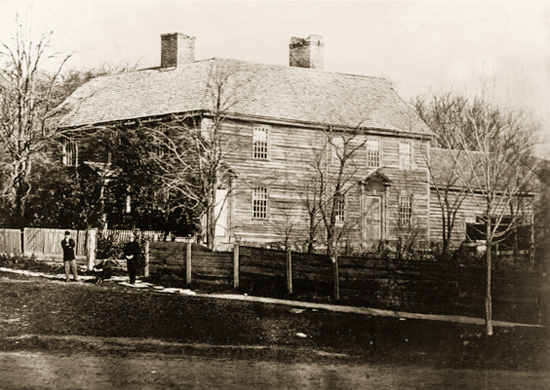
Fay's Tavern as it looked before it burned in the 19th century.
Burgoyne's strategy featured a three pronged attack. Burgoyne's forces would advance south from Canada, down Lake Champlain and on to the upper Hudson River Valley. At the same time a smaller force would move east from Oswego, in western New York, and through the Mohawk Valley. Third General William Howe would move his New York City based forces north, up the Hudson River. The plan was for all three armies to merge at Albany, New York.
At first Burgoyne's plan went well. They easily captured Fort Ticonderoga which the Americans had already vacated and then routed an American force under General Arthur St. Clair after some fierce fighting. Burgoyne then proceeded south toward Albany anticipating that he would meet British General, Barry St. Leger who was leading the eastern prong of the British offensive. St. Leger was stymied at his siege of Fort Stanwix and was unable to come to Burgoyne's aid.
On August 3, Burgoyne got some more bad news. General Howe announced that he was going to attack the patriot capital, Philadelphia, and that he would not be supporting Burgoyne in his New York operations. This crushing blow came as a result of a imprudent order from London. Lord Germain, who was the British minister in charge of the conduct of the war, had ordered Howe to attack both in New York and Philadelphia. Unable to do both, Howe had opted to take the patriot capital, which he did with comparative ease.
Burgoyne was now in an untenable position. As he moved further south, a growing number of hostile patriots were sounding his forces, and he was running out of supplies. Burgoyne needed food and other material. He also needed horses to pull his wagons and cannon and to provide mounts for his currently dismounted German mercenary cavalry. Burgoyne sent German Lieutenant Colonel Frederick Baum with a force of mercenaries, Indians and Tories to take Bennington, Vermont where there were stores of goods that Burgoyne's army needed.
The Battle of Bennington is one of the most underappreciated victories of the American Revolutionary War. A militia force under General John Stark and the Vermont militia under Seth Warner routed the Hessians and their Indian and Tory allies in a pitched battle. Over all the British lost almost 1,000 men including over 200 dead and 700 prisoners who were marched to Boston. This defeat convinced Britain's Indian allies to leave the field and many of the Tory adventurers abandoned their posts as well.
The loss at Bennington helped to seal Burgoyne's fate. In two battles at Freeman's Farm and Bemis Heights, which are now known collectively as the Battle of Saratoga, the British were defeated and forced to surrender.
On November 4, 1777 the Continental Congress voted to award a gold medal to General Horatio Gates who was in charge of the American army at Saratoga. Unfortunately the Congress did not recognize others, most notably Benedict Arnold, who took a leading role not only in the battles of Freeman's Farm and Bemis Heights but also in the stalemate at Fort Stanwix which stymied the British advance from the west.


The Horatio Gates Medal in Bronze, struck from the original die pair.
Arnold was badly wounded in the leg at Bemis Heights, and it took months for him to recover. Had he died at Saratoga he would have been remembered as a great American hero. Instead his internal demons, plus his desire for fast riches and adulation took control of him, and he became one of the most infamous traitors in American history.
The historical significance of this American victory went much further than a major British defeat. Once news of the battle reached France, the French Government, with some persuasive urging from Benjamin Franklin, made monetary and military commitments to the American cause for independence. The French commitment was based more a desire to embarrass, weaken and humiliate their long time British enemies than to advance the American ideals of liberty and equality.
Fast forward 150 years. In 1925 Congress voted to authorize a commemorative half dollar that would celebrate the sesquicentennial of Battle of Bennington and the independence of Vermont. The coin was to be issued in 1927, and the Vermont Historical Trust would use the funds from the sale of the coins to promote the study of Vermont and American history.
Final approval for the design of the Vermont commemorative half dollar was in the hands of the Fine Arts Commission. In some cases the commission acted as a rubber stamp, but in this case their "advisory role" became extremely heavy handed. The Fine Arts Commission vetoed almost all of the design ideas proposed by the Vermont Sesquicentennial Commission which was led by John Spargo.
The Fine Arts Commission rejected the initial design proposal by New England artist, Sherry Fry. It featured a small, unflattering portrait of Ira Allen, whose more famous big brother, Ethan Allan, was known for his leadership of the Green Mountain Boys. Ira, however, was the more historically influential of the two. The reverse of the Fry design pictured the Bennington Battle Monument, an obelisk that is over 300 feet high. After the rejection of his work, Fry bowed out of the project.
The Vermont Commission then hired Charles Keck to design the half dollar. Keck's initial design included a better portrait of Ira Allen on the obverse and view of Fay's Tavern on the reverse. Fay's Tavern had been a place where Ethan Allen and his men had met to drink and plot their strategy. Keck also developed an alternative "war trophy" reverse which included a drum, banners, crossed swords and stacked muskets.


The reverse of the Bennington Battle Medal was the first design proposed for the Vermont commemorative half Dollar. The Fine Arts Commissionn rejected it.
The Fine Arts Commission rejected the appearance of the tavern because they ruled that it was "an inartistic subject for a coin." In its place they strongly suggested that a catamount (a mountain cat) would be more appropriate. One of the alternative names for the watering hole had been the "Catamount Tavern." At one point the patriots had killed one of the beasts, stuffed it and used it as a sign to the British that they were not welcome there.
The catamount ultimately appeared on the reverse of the Vermont commemorative half dollar. Although it might be fine art, which many coin collectors admire, the symbolism has since been beyond the comprehension of most observers.

The Vermont commemorative half dollar.
In addition to the half dollar, the Vermont Sesquicentennial Commission also issued a commemorative medal. The Bennington Battle medal features a tribute to the backwoods militia men who fought the battle on the obverse, and the rejected view of Fay's Tavern on the reverse. The medal was also designed by Charles Keck, and in my opinion is a more appropriate tribute to the men who won the Battle of Bennington than the commemorative half dollar.
The Medallic Art Company reduced the models for the medal and half dollar from Charles Keck's plaster molds and stuck the Bennington Battle medal. Medallic Art charged the Vermont Commission $1 for each medal and the Commission sold them for $2 each. Overall the Commission ordered 500 medals, but Medallic Art produced additional pieces which they sold. The evidence of this were payments for royalties that Medallic Art made to the Vermont Commission. In addition there were six medals struck in "solid silver" that awarded to various dignitaries.

The reverse of the 2015 Saratoga America the Beautiful quarter.
In 2015, the U.S. Mint issued another tribute the Battle of Saratoga as a part of the America the Beautiful quarter program. The Saratoga, New York quarter features a sword held in an outstretched British military hand offered to an American hand in an act of surrender. The design on its surface appears to be overly simple. It is probably an acknowledgement that a complicated surrender scene, like the one that appears on the General Horatio Gates Medal, would overwhelm the small space available on a quarter. Nevertheless it is refreshing to note that an important event in our history, which seems to be mostly ignored today, is getting some credit on out modern coinage.

Fay's Tavern as it looked before it burned in the 19th century.


Comments
Saratoga National Historical Park contains many monuments. But only one commemorates the actions of a man who was instrumental in the American victory here, but later became a traitor to the United States: the infamous Benedict Arnold. The “Boot” monument is located at Stop 7 on the battlefield tour road. This monument is perhaps the most popular, unique, and controversial monument of the many placed here.
After he was wounded, General Arnold underwent surgery and after months of recuperation was assigned to command the repatriated capital city, Philadelphia, in June 1778.
There, Arnold’s resentment of perceived mistreatment boiled over into rage against the United States. He secretly sought British support and shared military intelligence. Exposed as a traitor at West Point in 1780, he escaped.
No one in American history is as vilified for treason as Benedict Arnold. The “Boot Monument” is dedicated to this man who led Americans to victory in the Battles of Saratoga.
Reading the Monument
The monument does not mention Arnold by name, but there are a few intricate details which often go unnoticed by passersby.
A boot and a two-star epaulet are draped over a howitzer barrel to symbolize an individual with the rank of Major General who suffered a wound during a battle in this location. A Laurel leaf wreath sits atop the howitzer, an emblem which often resonates victory, power, and glory.
The reverse of the monument is inscribed with the following quote:
“In memory of the most brilliant soldier of the Continental Army who was desperately wounded on this spot, the sally port of Burgoyne’s great [western] redoubt 7th October 1777 winning for his countrymen the decisive battle of the American Revolution and for himself the rank of Major General.”
Gates had group of friends in the Congress who were looking to have Gates replace George Washington as the general in chief. Thank goodness they failed. If Gates had been running things a Saratoga, we might not have won that battle and the war. He was timid and too weak attack when we had the British right where we wanted them. Arnold disobeyed orders and the attack that won the battle.
Later Gates showed his true incompetence when he fled in fear at the Battle of Camden during the southern phase of the Revolutionary War.
Yes, Daniel Morgan didn't have much use for Horatio Gates. He left the war the first time because he couldn't stand reporting to him.
Here is an example of the medal that was awarded to Morgan for his leadership at the Battle of the Cowpens. This is the most beautiful of the Libertas Americana medals in my opinion.
This bronze medal was struck by the French, circa 1838.
The family of Daniel Morgan discovered that the original gold medal that was awarded to him had been stolen. They asked the government for a replacement. The Morgan dies were one pair that never made it to the United States. The government borrowed the silver medal that is in the set that is currently held by the Massachusetts Historical Society and sent it to France. The French made virtually identical copies of it, struck a gold medal and also a few pieces in bronze. This medal is one of those pieces.
Here is another one that was struck from the same dies by the Philadelphia Mint, probably in the 1860s.
I collected this series "hot and heavy" for a number of years.
On my way to ski at Killington, I always pass the sign on I-91 that says "Windsor, Birthplace of Vermont 1777" which is where the Vermont Republic constitution was signed (at a tavern of course!).